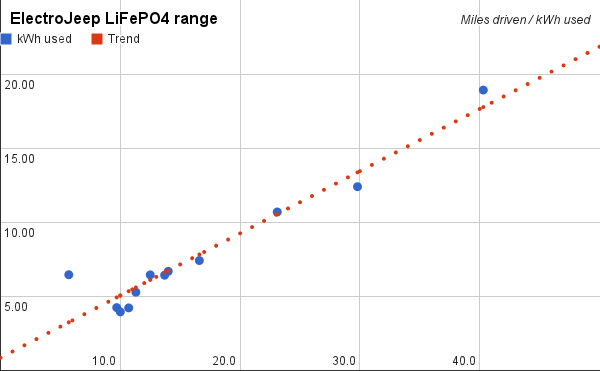A reality of the instrumentation and configuration of the ElectroJeep is that it requires some power even when not in use. Its DC-DC converter is always on, float-charging the accessory battery. Additionally, the MiniBMS modules consume some charge at all times.
I had the opportunity to measure this the last couple of weeks. For a variety of reasons, I did not end up driving the ElectroJeep between May 2 and May 17. I drove it about 6 miles yesterday, and then charged it. I've been keeping track of the charging energy, and here is what the chart shows, including yesterday:
Note the little dot way above the trend line on the lower left. That is yesterday. By simplistic calculations, yesterday's drive was expensive at 1135 Wh/mi (compared to the average of about 450 Wh/mi). But a little digging teases out the ongoing parasitic power consumption.
Yesterday's charge consumed 6.47 kWh. Using the least-squares trend, it should instead have used 3.26 kWh. The difference of 3.21 kWh, divided by the time (15 days), gives the ongoing parasitic power draw: about 8.9 watts. At the typical battery voltage of around 317 volts, this is about 28 milliamps. Looking at it another way, about 0.68 Ah of capacity are used each day, just sitting around. At my "70% DOD" threshold, this means I can leave it idle for about 100 days before needing to charge again.
Another thing of note: that 28 milliamp draw is too low for my EV Dashboard to detect - it thought the batteries were fairly near "full", even though they had lost about 10 Ah (10% of capacity) over the 15 days of idle time. I may contact the vendor to see if they might consider adding some sort of "correction" factor based on this kind of measurement.
I had the opportunity to measure this the last couple of weeks. For a variety of reasons, I did not end up driving the ElectroJeep between May 2 and May 17. I drove it about 6 miles yesterday, and then charged it. I've been keeping track of the charging energy, and here is what the chart shows, including yesterday:
Note the little dot way above the trend line on the lower left. That is yesterday. By simplistic calculations, yesterday's drive was expensive at 1135 Wh/mi (compared to the average of about 450 Wh/mi). But a little digging teases out the ongoing parasitic power consumption.
Yesterday's charge consumed 6.47 kWh. Using the least-squares trend, it should instead have used 3.26 kWh. The difference of 3.21 kWh, divided by the time (15 days), gives the ongoing parasitic power draw: about 8.9 watts. At the typical battery voltage of around 317 volts, this is about 28 milliamps. Looking at it another way, about 0.68 Ah of capacity are used each day, just sitting around. At my "70% DOD" threshold, this means I can leave it idle for about 100 days before needing to charge again.
Another thing of note: that 28 milliamp draw is too low for my EV Dashboard to detect - it thought the batteries were fairly near "full", even though they had lost about 10 Ah (10% of capacity) over the 15 days of idle time. I may contact the vendor to see if they might consider adding some sort of "correction" factor based on this kind of measurement.

